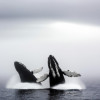
Whales are highly intelligent and emotional creatures that use a variety of communication methods to interact with each other. In fact, their communication methods are some of the most advanced in the animal kingdom. This article explores the fascinating ways in which whales communicate.
Vocalizations
Whales are renowned for their vocalizations, which can be heard over long distances in the ocean. These vocalizations take the form of songs, clicks, whistles, and grunts. For example, humpback whales are known for their complex songs, which can last for hours and are repeated over and over again. Scientists believe that these songs play an important role in mating and social bonding. Meanwhile, sperm whales produce clicks that are the loudest sounds made by any animal on Earth, and use these clicks for echolocation and communication with other sperm whales.
Body language
In addition to vocalizations, whales also use body language to communicate. For example, humpback whales often breach the water and slap their fins or tails on the surface, which scientists believe may be a way of attracting a mate or indicating aggression. Similarly, killer whales have a range of body language signals, such as posturing, circling, and tail slapping, that they use to communicate with each other.
Chemical communication
Whales also use chemical communication to interact with each other. For example, male sperm whales produce a substance called ambergris, which is used in perfumes and is thought to play a role in the social hierarchy of the whale pod. Meanwhile, other species of whales release pheromones, which can signal reproductive readiness or help whales identify each other.
Conclusion
In conclusion, whales are remarkable creatures with highly advanced communication methods. From vocalizations and body language to chemical signals, these creatures use a range of techniques to communicate and interact with each other in the ocean. Understanding these communication methods is not only fascinating, but crucial for ensuring the survival of these magnificent animals in the wild.
















